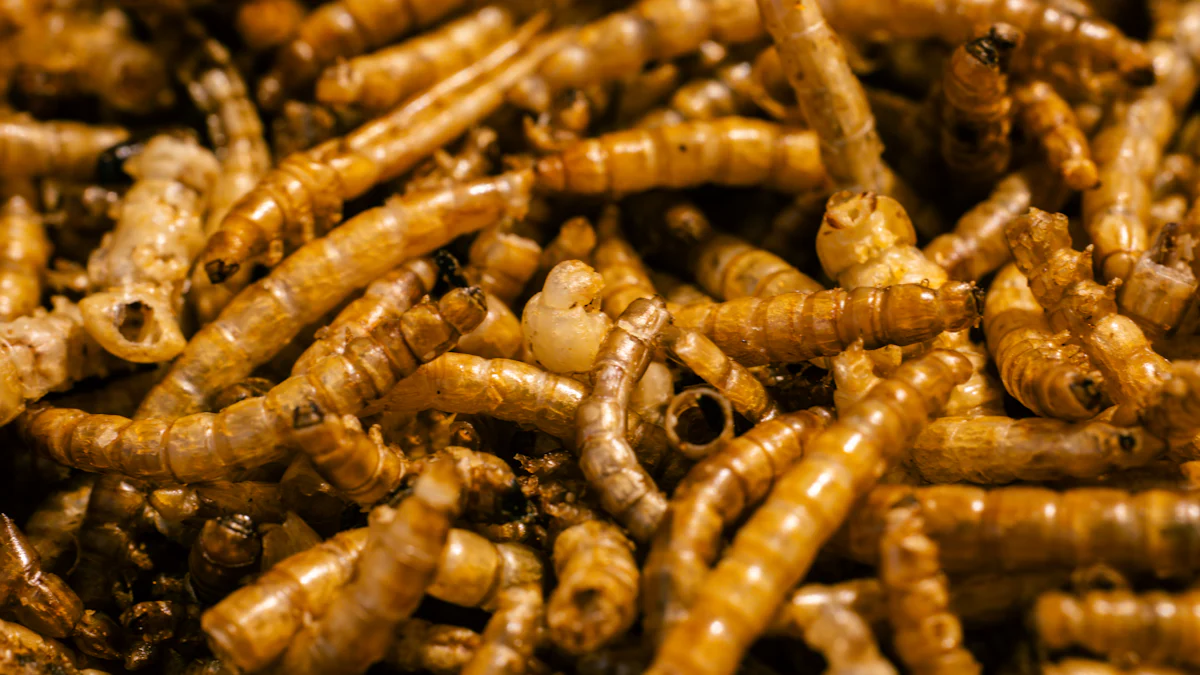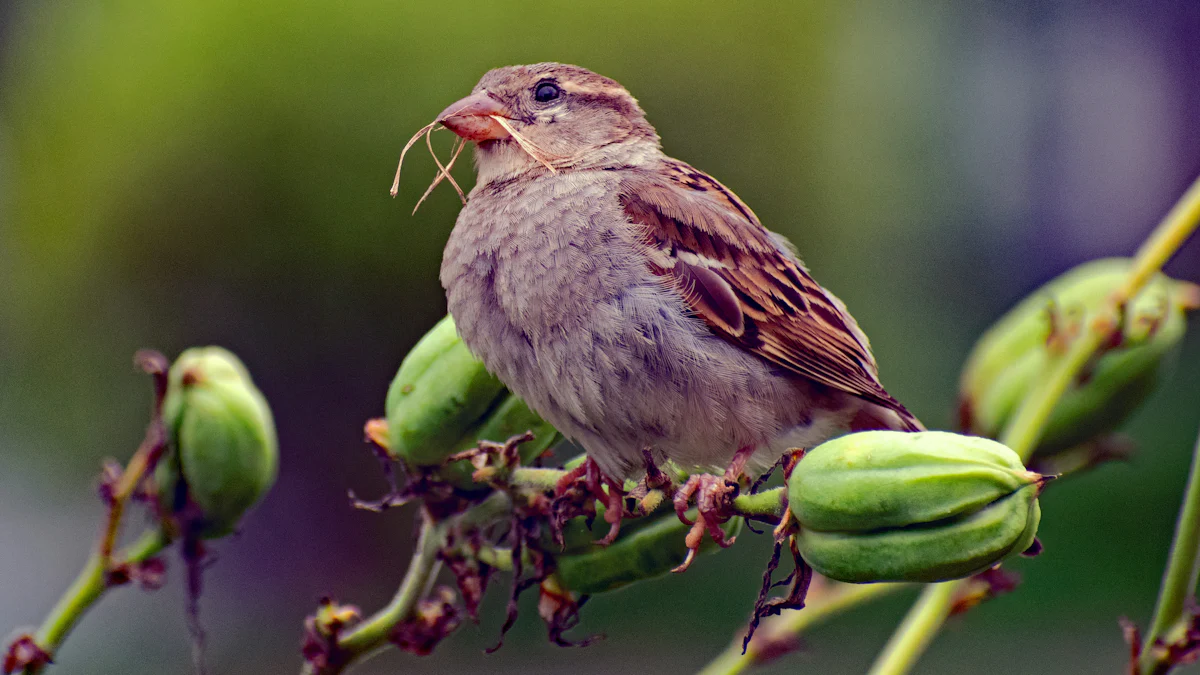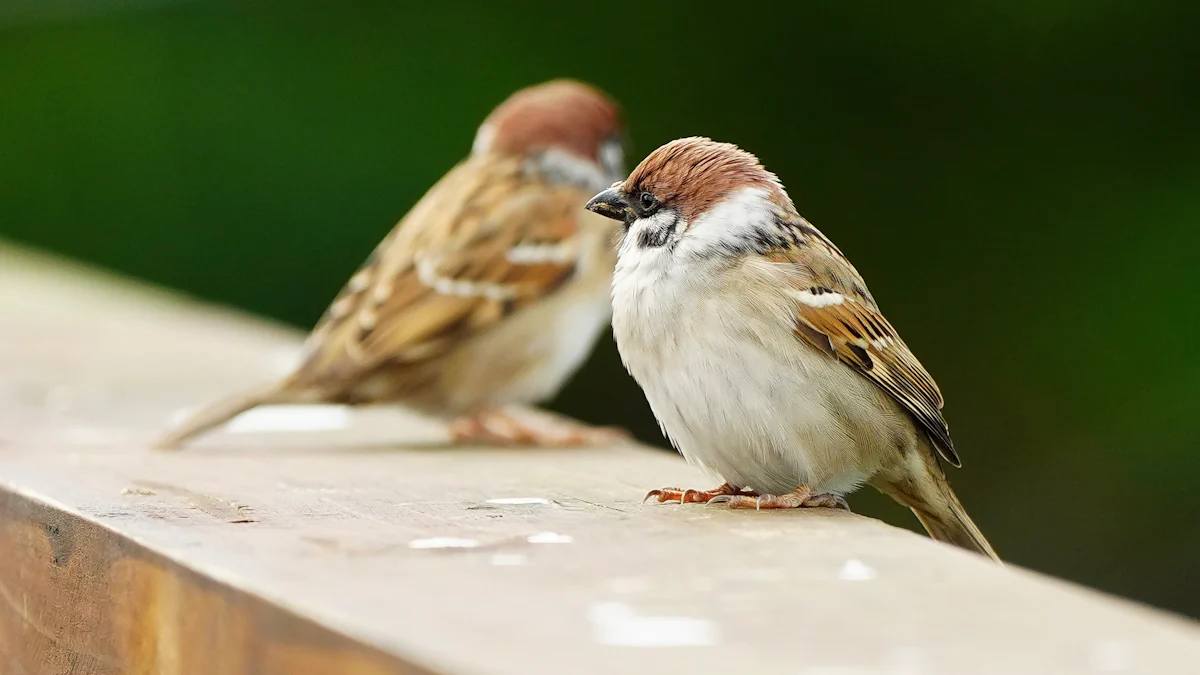
Have you ever watched sparrows hopping around your yard, pecking at seeds or insects? These little birds are known for their adaptability, but did you know sparrows eat dried mealworms too? While seeds and grains might be their go-to snacks, dried mealworms offer a protein-packed alternative. They’re especially helpful during colder months or when sparrows are feeding their chicks. To make them more appealing, you can soak the mealworms in water, mimicking the texture of live insects. With the right approach, you can turn your yard into a sparrow-friendly haven.
Key Takeaways
- Dried mealworms are a nutritious food source for sparrows, rich in protein, fat, and fiber, essential for their health and energy.
- Soaking dried mealworms in water for 20-30 minutes enhances their appeal, mimicking the texture of live insects that sparrows prefer.
- Timing is crucial; offer dried mealworms during winter and breeding season when sparrows need extra nutrition to thrive.
- Use platform feeders or shallow dishes in quiet, sheltered areas to attract sparrows while keeping them safe from predators.
- Mixing dried mealworms with seeds or grains can encourage sparrows to try them and ensure a balanced diet.
- Adjust your feeding habits seasonally to meet sparrows’ changing nutritional needs, especially during colder months and breeding times.
- To manage costs, consider buying dried mealworms in bulk and treat them as a special addition rather than a daily staple.
Why Sparrows Eat Dried Mealworms

Sparrows might not immediately go for dried mealworms, but these tiny treats pack a punch when it comes to nutrition. Understanding why sparrows eat dried mealworms can help you make better choices when feeding them. Let’s dive into the benefits and timing that make mealworms a valuable addition to their diet.
Nutritional Benefits of Dried Mealworms
Dried mealworms are like a superfood for sparrows. They’re rich in protein, fat, and fiber, which are essential for a bird’s health. Protein plays a key role in keeping their feathers strong and shiny. Without enough protein, sparrows may develop dull or brittle feathers, which can affect their ability to fly and stay warm. Fat provides energy, especially during colder months when sparrows need extra fuel to survive. Fiber helps with digestion, ensuring they stay healthy and active.
One interesting tip is to soak dried mealworms in water for about 30 minutes before offering them. This simple step adds hydration, making the mealworms more appealing and easier to eat. It also mimics the texture of live insects, which sparrows naturally prefer. By doing this, you’re giving them both nutrition and hydration in one bite.
When Sparrows Are Most Likely to Eat Dried Mealworms
Timing matters when feeding sparrows. They’re most likely to eat dried mealworms during specific periods, such as winter or breeding season. In winter, natural food sources like seeds and insects become scarce. Sparrows eat dried mealworms more eagerly during this time because they provide the protein and fat needed to stay warm and energized.
During the breeding season, sparrows need extra nutrition to feed their chicks. Dried mealworms become a convenient option since they’re packed with the nutrients young birds need to grow. You might notice sparrows visiting your feeder more often during these times, especially if you’ve made the mealworms easy to access and appealing.
How Dried Mealworms Compare to Other Food Sources
Sparrows have a varied diet, but how do dried mealworms stack up against their usual favorites like seeds or grains? While seeds are a staple for sparrows, they don’t offer the same level of protein and fat as mealworms. Grains provide energy but lack the balanced nutrition that mealworms deliver. Live insects are closer to what sparrows eat in the wild, but they’re not always practical to offer.
Dried mealworms strike a balance between convenience and nutrition. They’re easy to store, don’t spoil quickly, and can be used year-round. By soaking them, you can even replicate some of the benefits of live insects. Offering a mix of seeds, grains, and dried mealworms ensures sparrows get a well-rounded diet that meets all their needs.
How to Feed Sparrows Dried Mealworms

Feeding sparrows dried mealworms can be a rewarding experience. With the right techniques, you can make these protein-packed treats irresistible to your feathered visitors. Let’s explore some simple yet effective ways to offer dried mealworms to sparrows.
Soaking Dried Mealworms for Better Appeal
Sparrows naturally prefer live insects because of their moisture and texture. Dried mealworms, while convenient, lack that natural moistness. To bridge this gap, you can soak dried mealworms in water for about 20–30 minutes before serving them. This process softens the mealworms, making them more appealing and easier for sparrows to eat.
Soaking also adds hydration, which is especially beneficial during hot summer days or when sparrows are feeding their chicks. Place the soaked mealworms in a shallow dish or feeder, and watch as sparrows flock to enjoy this treat. If you’re short on time, even a quick rinse can make a difference in how sparrows respond to the mealworms.
Choosing the Right Feeder and Placement
The type of feeder and its placement play a big role in attracting sparrows. Sparrows prefer open spaces where they feel safe from predators. A platform feeder or a shallow dish works best for offering dried mealworms. Avoid feeders with narrow openings, as they might make it harder for sparrows to access the food.
Place the feeder in a quiet, sheltered spot in your yard. Sparrows feel more comfortable feeding in areas with nearby shrubs or trees, which provide cover and a quick escape route if needed. Keep the feeder clean and refill it regularly to maintain a welcoming environment for sparrows.
Mixing Dried Mealworms with Other Foods
Sparrows eat dried mealworms, but they also enjoy a variety of other foods like seeds and grains. Mixing dried mealworms with their favorite seeds can encourage them to try something new. For example, you can combine mealworms with sunflower seeds or millet in a single feeder. This mix not only attracts sparrows but also ensures they get a balanced diet.
During colder months or breeding season, you can increase the proportion of mealworms in the mix to provide extra protein and energy. Experiment with different combinations to see what works best for the sparrows in your area. By offering variety, you’ll keep them coming back for more.
Seasonal Considerations for Feeding Sparrows
Understanding the seasonal needs of sparrows can help you provide the right food at the right time. Dried mealworms are a versatile option that can benefit sparrows throughout the year. Let’s explore how these protein-packed treats can support sparrows in winter, during breeding season, and in the warmer months.
Benefits of Dried Mealworms in Winter
Winter is a challenging time for sparrows. Natural food sources like seeds and insects become scarce, and the cold weather demands more energy to stay warm. Dried mealworms can be a lifesaver for sparrows during this season. They’re rich in protein and fat, which are essential for maintaining energy levels and body heat.
By offering dried mealworms in winter, you give sparrows a reliable source of nutrition when they need it most. Place the mealworms in a feeder that’s easy to access, especially during snowy or icy conditions. Soaking them in water before serving adds hydration, which is just as important as food during the colder months. You’ll likely notice sparrows visiting your feeder more often, grateful for the extra help.
Supporting Sparrows During Breeding Season
Breeding season is another critical time for sparrows. Parent sparrows work tirelessly to feed their chicks, often making countless trips to find food. Dried mealworms are an excellent choice during this period because they’re easy to carry and packed with nutrients that young birds need to grow strong.
You can support sparrows by increasing the availability of dried mealworms in your yard during the breeding season. Mix them with seeds or grains to create a balanced diet for the adult birds while ensuring the chicks get the protein they require. Keep the feeder clean and well-stocked to encourage frequent visits. Watching sparrows care for their young can be a rewarding experience, and your efforts will make a real difference.
Adjusting Feeding Habits in Summer and Fall
Summer and fall bring different challenges for sparrows. In summer, hydration becomes a priority. Soaking dried mealworms before offering them can help sparrows stay hydrated while enjoying a nutritious snack. Place the mealworms in a shaded area to keep them fresh and appealing during hot days.
In fall, sparrows start preparing for the colder months ahead. They need to build up their energy reserves, making high-protein foods like dried mealworms an excellent choice. You can gradually increase the amount of mealworms you offer as the weather cools, helping sparrows transition into winter with the strength they need to thrive.
By adjusting your feeding habits to match the seasons, you can ensure sparrows eat dried mealworms year-round and stay healthy no matter the time of year.
Challenges and Solutions When Feeding Sparrows
Feeding sparrows dried mealworms can be a delightful experience, but it’s not without its challenges. From managing other birds to keeping your feeding area clean, there are a few hurdles you might face. Let’s explore some common issues and practical solutions to make your bird-feeding efforts more enjoyable.
Attracting Sparrows While Discouraging Other Birds
Sparrows aren’t the only birds that enjoy dried mealworms. Starlings, for example, often swoop in and devour mealworms before sparrows get a chance. This can be frustrating, especially if you’re trying to cater specifically to sparrows.
To attract sparrows while keeping other birds at bay, consider using a feeder designed for smaller birds. Platform feeders with low edges or feeders with adjustable openings work well. Place the feeder in a quiet spot near shrubs or trees where sparrows feel safe. Avoid open areas where larger birds might dominate.
“I’ve been feeding live mealworms to Bluebirds and Cardinals for years, but this year sparrows are devouring them as soon as I put them out,” shared one bird enthusiast. This highlights how sparrows can sometimes outcompete other birds, but the reverse can also happen. Adjusting your feeder setup can help balance the competition.
If larger birds persist, try offering mealworms in smaller quantities throughout the day. This limits how much other birds can take at once, giving sparrows more opportunities to feed.
Preventing Waste and Keeping Feeding Areas Clean
Dried mealworms are a fantastic food source, but they can create waste if not managed properly. Uneaten mealworms may attract pests or spoil, especially in warm weather. Keeping your feeding area clean is essential for the health of sparrows and the overall environment.
Start by offering small portions of mealworms. Observe how much the sparrows eat in one sitting and adjust the amount accordingly. This minimizes leftovers and reduces waste. If you notice mealworms piling up, reduce the quantity further.
Regularly clean your feeder and the surrounding area. Remove any spilled mealworms or debris to prevent attracting unwanted pests. A shallow dish or platform feeder makes cleanup easier.
“I soak my mealworms overnight and use a piece of kitchen roll to ensure they’re fully hydrated,” one bird lover shared. This method not only makes mealworms more appealing but also prevents them from drying out and becoming unappetizing.
By maintaining a clean feeding area, you create a safe and inviting space for sparrows to visit.
Budget-Friendly Tips for Using Dried Mealworms
Dried mealworms are nutritious, but they can be pricey if you’re feeding birds regularly. Finding ways to stretch your budget while still providing for sparrows is key.
One cost-effective strategy is to mix dried mealworms with other foods sparrows enjoy, like seeds or grains. This creates a balanced diet while reducing the amount of mealworms you need. For example, combine mealworms with sunflower seeds or millet in a single feeder. Sparrows will still benefit from the protein in mealworms without breaking the bank.
“I know mealworms are expensive, so I give them out as a treat,” said one bird enthusiast. Treating mealworms as a special addition rather than a daily staple can help manage costs. Offer them during critical times, like winter or breeding season, when sparrows need extra nutrition.
Buying mealworms in bulk is another way to save money. Look for deals online or at local stores. Properly store them in a cool, dry place to ensure they last longer.
By being mindful of your feeding habits and exploring budget-friendly options, you can continue supporting sparrows without overspending.
Feeding sparrows dried mealworms comes with its challenges, but with these tips, you can overcome them. Whether it’s managing other birds, keeping your feeding area clean, or staying within budget, small adjustments can make a big difference. Enjoy the rewarding experience of watching sparrows thrive in your yard!
Sparrows eat dried mealworms, and adding them to your bird-feeding routine can make a big difference. These protein-packed treats support healthy feather growth, provide energy, and help sparrows thrive during challenging seasons. By soaking mealworms, choosing the right feeder, and adjusting your feeding habits, you create a welcoming space for these birds. Watching sparrows enjoy their meals is not only rewarding but also a chance to connect with nature. Start incorporating dried mealworms today and enjoy the lively presence of sparrows in your yard.
FAQ
Will sparrows eat dried mealworms?
Yes, sparrows will eat dried mealworms, though they might not choose them first over seeds or live insects. Dried mealworms provide a nutritious option, especially during times when natural food sources are limited. If you’re introducing them for the first time, try soaking the mealworms in water to make them more appealing. Once sparrows get used to them, you’ll likely see them coming back for more.
“So, give dried mealworms a try in your feeders. Your birds will thank you!” This advice highlights how beneficial and appreciated dried mealworms can be for your feathered visitors.
How do I make dried mealworms more attractive to sparrows?
Soaking dried mealworms in water for 20–30 minutes can make a big difference. This process softens the mealworms and mimics the texture of live insects, which sparrows naturally prefer. You can also mix the mealworms with seeds or grains to encourage sparrows to try them. Placing the food in a shallow dish or platform feeder makes it easier for sparrows to access.
Can I feed dried mealworms to sparrows year-round?
Absolutely! Dried mealworms are suitable for sparrows throughout the year. In winter, they provide essential protein and fat to help sparrows stay warm. During breeding season, they offer the nutrients needed for feeding chicks. In summer, soaked mealworms can help with hydration. Adjust the quantity based on the season to meet the sparrows’ needs.
What type of feeder works best for dried mealworms?
A platform feeder or a shallow dish works best for offering dried mealworms to sparrows. These feeders allow easy access and make sparrows feel safe while eating. Place the feeder in a quiet spot near shrubs or trees, where sparrows can quickly retreat if they sense danger. Avoid feeders with narrow openings, as they might make it harder for sparrows to reach the food.
How much should I feed sparrows?
Start with small portions of dried mealworms and observe how much the sparrows eat. Gradually adjust the amount based on their feeding habits. Overfeeding can lead to waste and attract pests, so it’s better to offer smaller amounts and refill as needed. During winter or breeding season, you might need to increase the quantity to meet their higher energy demands.
Do other birds eat dried mealworms too?
Yes, many birds enjoy dried mealworms, including robins, bluebirds, and starlings. If you want to focus on feeding sparrows, consider using a feeder designed for smaller birds. You can also place the feeder in a location that sparrows frequent, such as near shrubs or low branches, to give them an advantage over larger birds.
Are dried mealworms expensive to use regularly?
Dried mealworms can be pricey, but there are ways to make them more budget-friendly. Mixing them with seeds or grains stretches your supply while still providing nutrition. Buying in bulk often reduces the cost per ounce. Treating mealworms as a special addition during critical times, like winter or breeding season, can also help manage costs.
Can dried mealworms spoil?
Dried mealworms have a long shelf life if stored properly. Keep them in a cool, dry place to prevent spoilage. If you soak mealworms before feeding, only prepare what sparrows can eat in one sitting to avoid waste. Regularly clean your feeder to ensure the food stays fresh and appealing.
Why aren’t sparrows eating the dried mealworms I put out?
Sparrows might need time to get used to dried mealworms, especially if they’re accustomed to seeds or grains. Soaking the mealworms can make them more enticing. Placement matters too—ensure the feeder is in a quiet, safe spot. Mixing mealworms with their favorite seeds can also encourage them to try something new.
Can I mix dried mealworms with other foods?
Yes, mixing dried mealworms with seeds or grains is a great way to offer variety and balance. Sparrows enjoy foods like sunflower seeds, millet, and cracked corn. Combining these with mealworms ensures they get a mix of protein, fat, and energy. Experiment with different combinations to see what works best for the sparrows in your area.


